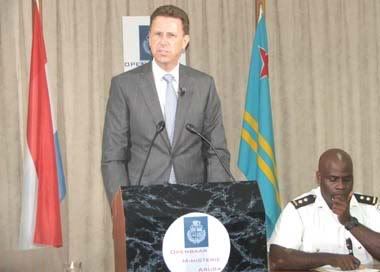Public Ministry reveals what the new evidence was in the Holloway case
Diario Aruba
12/21/2007
ORANJESTAD(AAN):
Chief prosecutor Hans Mos started by saying that the Public Ministry no longer holds the trio as suspects.
He said that this decision was not taken lightly, and that the Public Ministry evaluated every aspect along with jurists are their disposal and jointly the conclusion was reached that finally the investigation did not produce enough legal evidence to be able to bring the case successfully before a judge.
Mos continued to say that if the case had been brought forth, he is sure that the suspects would have been acquitted of all accusations. Given that the Public Ministry arrived at this conclusion, it was against the O.M.’s professional code to bring this case to court.
After explaining how the investigation proceeded, among other things under the guidance of a new team, prosecutor Mos continued to say that they made use of all available tools to be able to bring the suspects in front of a judge, but unsuccessfully.
He said that given that the new evidence was brought up and that he truly felt that the Public Ministry could have achieved something with this, he preferred to make an attempt to be able to find more material to bring the case forward, rather than not try.
As to the new evidence, Mos explained that when the Public Ministry spoke of the new evidence, it referred to all evidence that had been found after the three suspects were set free after July 2005.
Given that the evidence was found after that they were released, they could consider it as new evidence, for which once again the suspects could be re-detained and the judge was in agreement that there was sufficient reason to do this.
Mos brought up that an important clue that the O.M. found was a female witness who came forward in June 2007. This witness told the O.M. about a telephone conversation that she had with one of the suspects, exactly 5 hours and 13 minutes after Natalee Holloway was last seen alive for the last time, according to the O.M.
The witness said that during the conversation, she could hear that something wasn’t right with the person. She asked the boy what happened and as an answer he told the girl that he didn’t want to get her in trouble and that what happened could not be told over the phone.
Aside from this, there was a declaration from a witness relating to the bahaviour of one of the other suspects on the day of the disappearance of Natalee. Furthermore, a digital search was conducted on the hard drives of the 3 suspects’ computers and on the computers of others as well.
One of these chats referred to the fact that Natalee was dead. This search was better able to determine a so-called ‘time line’ in regards to the disappearance of Natalee. The technicians in the digital search are technicians who did not have access to these earlier in the investigation.
The reconstructed time line, combined with facts found earlier and the information given by the suspects in their declarations, made the O.M. conclude that the last version given by the suspects could not fit with the truth.
Because of this there were big questions about the 3 suspects’ alibis. Another new evidence was a recording made in the Kalpoe brothers’ home.
Prosecutor Mos brought up that additionally, with the different interviews that Joran and his father gave to different Dutch media, it gave the impression that they had more information than they had given.
The problem was that there was little direct evidence to be able to bring the case in front of a judge. The fact that the three suspects made use of their right to remain silent also made it very difficult to make the case.
The Public Ministry had to take a decision to declare the kids no longer suspects in this case because according to the law, this has to be done within a reasonable period of time, in order for the O.M. not to lose its right to prosecute this case.
Now that the decision has been taken, it does not mean that the investigation into this case will not continue, rather that a different phase begins.
All new evidence that surfaces will be added to the evidence they already have, to see if they could still make a criminal case. If there’s enough evidence, they can still begin a criminal case against the 3 suspects.
However, one has to take into account the term [statute of limitations] that the law has for this. According to Mos, the law sets a term of 6 years for voluntary manslaughter, while for murder, the term by which the case against the suspects must be made is 12 years.
If after 12 years any important evidence is found, the suspects could no longer be criminally prosecuted.
Mos explained that there are some special agents available to continue the investigation and this is important, because there are various people who have come forward who have said that they have certain information that could help in the investigation.
Because of this, the chief prosecutor made an appeal for any persons who have information, to come forward with it.
[translated by Getagrip]
